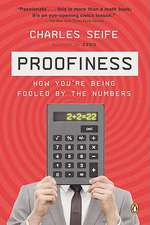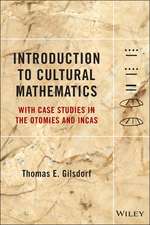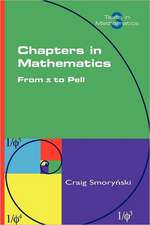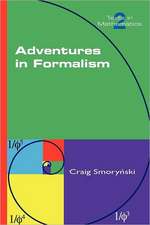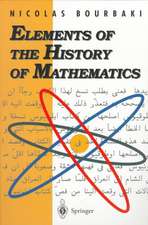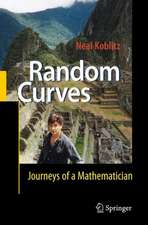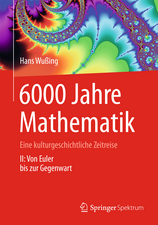A History of Folding in Mathematics: Mathematizing the Margins: Science Networks. Historical Studies, cartea 59
Autor Michael Friedmanen Limba Engleză Hardback – 6 iun 2018
Aiming to answer these questions, this volume provides, for the first time, an extensive historical study on the history of folding in mathematics, spanning from the 16th century to the 20th century, and offers a general study on the ways mathematical knowledge is marginalised, disappears, is ignored or becomes obsolete.
In doing so, it makes a valuable contribution to the field of history and philosophy of science, particularly the history and philosophy of mathematics and is highly recommended for anyone interested in these topics.
| Toate formatele și edițiile | Preț | Express |
|---|---|---|
| Paperback (1) | 1386.80 lei 43-57 zile | |
| Springer International Publishing – 15 ian 2019 | 1386.80 lei 43-57 zile | |
| Hardback (1) | 1392.95 lei 43-57 zile | |
| Springer International Publishing – 6 iun 2018 | 1392.95 lei 43-57 zile |
Din seria Science Networks. Historical Studies
- 18%
 Preț: 796.31 lei
Preț: 796.31 lei - 15%
 Preț: 652.49 lei
Preț: 652.49 lei - 18%
 Preț: 787.15 lei
Preț: 787.15 lei -
 Preț: 385.25 lei
Preț: 385.25 lei -
 Preț: 489.30 lei
Preț: 489.30 lei - 15%
 Preț: 476.75 lei
Preț: 476.75 lei -
 Preț: 389.31 lei
Preț: 389.31 lei - 15%
 Preț: 699.59 lei
Preț: 699.59 lei - 15%
 Preț: 660.37 lei
Preț: 660.37 lei - 15%
 Preț: 531.59 lei
Preț: 531.59 lei - 24%
 Preț: 909.25 lei
Preț: 909.25 lei -
 Preț: 396.24 lei
Preț: 396.24 lei - 18%
 Preț: 903.17 lei
Preț: 903.17 lei -
 Preț: 382.36 lei
Preț: 382.36 lei -
 Preț: 395.25 lei
Preț: 395.25 lei - 15%
 Preț: 647.73 lei
Preț: 647.73 lei - 15%
 Preț: 702.87 lei
Preț: 702.87 lei - 15%
 Preț: 674.74 lei
Preț: 674.74 lei - 15%
 Preț: 655.60 lei
Preț: 655.60 lei - 15%
 Preț: 650.19 lei
Preț: 650.19 lei - 15%
 Preț: 644.82 lei
Preț: 644.82 lei - 15%
 Preț: 646.62 lei
Preț: 646.62 lei - 18%
 Preț: 1119.08 lei
Preț: 1119.08 lei - 18%
 Preț: 1140.86 lei
Preț: 1140.86 lei - 20%
 Preț: 595.47 lei
Preț: 595.47 lei - 20%
 Preț: 596.59 lei
Preț: 596.59 lei - 15%
 Preț: 649.06 lei
Preț: 649.06 lei - 20%
 Preț: 567.62 lei
Preț: 567.62 lei - 15%
 Preț: 644.95 lei
Preț: 644.95 lei -
 Preț: 399.12 lei
Preț: 399.12 lei - 18%
 Preț: 1390.11 lei
Preț: 1390.11 lei -
 Preț: 361.03 lei
Preț: 361.03 lei - 18%
 Preț: 1395.63 lei
Preț: 1395.63 lei - 15%
 Preț: 642.36 lei
Preț: 642.36 lei - 15%
 Preț: 648.24 lei
Preț: 648.24 lei - 15%
 Preț: 649.06 lei
Preț: 649.06 lei -
 Preț: 392.37 lei
Preț: 392.37 lei
Preț: 1392.95 lei
Preț vechi: 1698.72 lei
-18% Nou
Puncte Express: 2089
Preț estimativ în valută:
266.54€ • 278.99$ • 221.85£
266.54€ • 278.99$ • 221.85£
Carte tipărită la comandă
Livrare economică 31 martie-14 aprilie
Preluare comenzi: 021 569.72.76
Specificații
ISBN-13: 9783319724867
ISBN-10: 331972486X
Pagini: 415
Ilustrații: XV, 419 p. 134 illus., 42 illus. in color.
Dimensiuni: 155 x 235 mm
Greutate: 0.79 kg
Ediția:1st ed. 2018
Editura: Springer International Publishing
Colecția Birkhäuser
Seria Science Networks. Historical Studies
Locul publicării:Cham, Switzerland
ISBN-10: 331972486X
Pagini: 415
Ilustrații: XV, 419 p. 134 illus., 42 illus. in color.
Dimensiuni: 155 x 235 mm
Greutate: 0.79 kg
Ediția:1st ed. 2018
Editura: Springer International Publishing
Colecția Birkhäuser
Seria Science Networks. Historical Studies
Locul publicării:Cham, Switzerland
Cuprins
Introduction.- From the 16th Century Onwards: Folding Polyhedra. New Epistemological Horizons?.- Prolog to the 19th Century: Accepting Folding as a Method of Inference.- The 19th Century – What Can and Cannot be (Re)presented: On Models and Kindergartens.- Towards the Axiomatization, Operationalization and Algebraization of the Fold.- The Axiomatization(s) of the Fold.- Appendix I: Margherita Beloch Piazzolla: “Alcune applicazioni del metodo del ripiegamento della carta di Sundara Row”.- Appendix II: Deleuze, Leibniz and the Unmathematical Fold.- Bibliography.- List of Figures.
Recenzii
“Friedman’s new book is the first modern scholarly account of the history of mathematical paper folding. … His insights and detailed scholarship make this an invaluable source book for anyone interested in the history of mathematics. … Summing Up: Recommended. Upper-division undergraduates and above.” (R. L. Pour, Choice, Vol. 56 (05), January, 2019)
“The work offers a wealth of mathematical and historical information on a wide selection of topics that involve folding. … the author provides general readers, as well as historians and mathematicians, with a fascinating, well-researched, richly illustrated, well-referenced, and valuable resource on the history of paper folding and its mathematical aspects.” (James J. Tattersall, Mathematical Reviews, January, 2019)
Textul de pe ultima copertă
While it is well known that the Delian problems are impossible to solve with a straightedge and compass – for example, it is impossible to construct a segment whose length is the cube root of 2 with these instruments – the discovery of the Italian mathematician Margherita Beloch Piazzolla in 1934 that one can in fact construct a segment of length the cube root of 2 with a single paper fold was completely ignored (till the end of the 1980s). This comes as no surprise, since with few exceptions paper folding was seldom considered as a mathematical practice, let alone as a mathematical procedure of inference or proof that could prompt novel mathematical discoveries. A few questions immediately arise: Why did paper folding become a non-instrument? What caused the marginalisation of this technique? And how was the mathematical knowledge, which was nevertheless transmitted and prompted by paper folding, later treated and conceptualised?
Aiming to answerthese questions, this volume provides, for the first time, an extensive historical study on the history of folding in mathematics, spanning from the 16th century to the 20th century, and offers a general study on the ways mathematical knowledge is marginalised, disappears, is ignored or becomes obsolete.
In doing so, it makes a valuable contribution to the field of history and philosophy of science, particularly the history and philosophy of mathematics and is highly recommended for anyone interested in these topics.
Aiming to answerthese questions, this volume provides, for the first time, an extensive historical study on the history of folding in mathematics, spanning from the 16th century to the 20th century, and offers a general study on the ways mathematical knowledge is marginalised, disappears, is ignored or becomes obsolete.
In doing so, it makes a valuable contribution to the field of history and philosophy of science, particularly the history and philosophy of mathematics and is highly recommended for anyone interested in these topics.
Caracteristici
Provides a lucid exposition on the history of the mathematical concept of folding starting from the 16th century Researches the various ways in which mathematical knowledge was and is marginalized Surveys clearly the ways in which mathematical research and mathematical inference procedures were changing during the centuries

